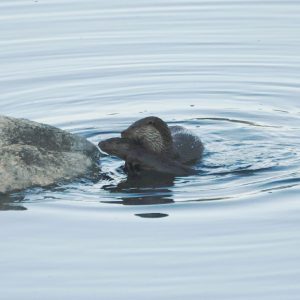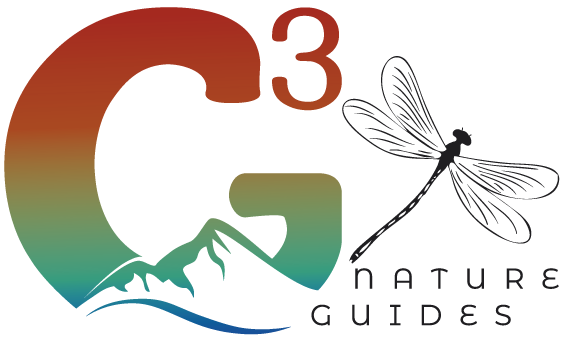A month with the lynx in Sierra de Andújar
A month of January 2025 placed under the sign of the large cat, until recently the most endangered in the world… with less than 100 lynx at the beginning of the 2000s. We were lucky enough to spend beautiful days in Andújar with plenty of interesting observations.
This original report by G3 Guides and published in “Nature in Andalusia and beyond” can be downloaded as a pdf. Ten days were dedicated to guide for the “Wild Return” series which took place in Andalusia.

The female lynx #Magarza#, one-eyed during the winter of 2024/2025, received veterinary follow-up with the placement of a collar.
Andújar, Andalusia
January 2025
FRIDAY 3 – We arrive in Andújar (Andalusia) to begin our season in this, now legendary, Sierra Morena with the hope of seeing as many lynx as possible. Very quickly, granite and oaks cover the landscape. We head straight towards Los Escoriales. On the route, we enjoy good quantities of Red deer (Cervus elaphus hispanicus), Fallow deer (Dama dama), European mouflons (Ovis orientalis musimon) and soon the Iberian ibex (Capra pyrenaica hispanica) [1]. It is difficult to find another place in Europe with such a density of large herbivores. It’s a joy… even if the animals are perhaps too calm, given the lack of the super predator which should control their populations.

On the rock wall of La Lancha (toponym for a rather very large stone), a curled up and lazy fox (Vulpes vulpes silacea), enjoys a long rest under the weak sun.
In the meadow of the Casa de Madroñalejo, now abandoned, we witness an unusual gathering of birds: an imperial eagle (Aquila adalberti) seems to receive complaints from a couple of black vultures (Aegypius monachus), of a few ravens (Corvus corax) and a good number of spotless starlings (Sturnus unicolor). Tired of so many complaints, the bird of prey flies away and disappears behind the hills. At the end of the afternoon, we observed from afar an Iberian lynx (Lynx pardinus) who walks furtively on a track at the Finca de los Escoriales… Too quick a moment, but we are satisfied at this first sighting of the true king of the Mediterranean forest.
SATURDAY 4 – We dedicate the day to El Encinarejo, arriving early to take our seats before nightfall. It’s freezing cold, with temperatures below -3ºC, but the reward is immense.

I had never observed such a movement of palearctic otters (Lutra lutra) for so long. Picture: Éric Petit.
The spectacle is striking, with several individuals Palearctic otters (Lutra lutra) fishing together in the Jándula River. Their ivory teeth contrast with the dark background. They slide between the stones with great agility. Lots of games in the water… The observation is at its peak when three heads emerge together in the same plane. An indelible image. In the distance, another pair of otters move away following the current… The cold bites us and it is time to retreat. Along the way we meet a group of observers at the Barranco de San Miguel observatory but the lynx has already disappeared.
The recently introduced European bisons (Bison bonasus) are seen near Casa del Encinarejo Alto. After a restorative coffee, we retrace our steps. On Cerro Torviscales, two black vultures (A. monachus) preen their feathers on a high rock. At midday, the immense reservoir offers us a refuge to escape the small crowd of observers present at the recreational area. We return to the Barranco. A European robin (Erithacus rubecula) approaches without fear, faithful to the custom of its species. Little activity on the spot… nevertheless an Imperial (Aquila adalberti) animates our expectations.

Typical landscape in Sierra de Andújar.
SUNDAY 5 – We settle early on the first granite chaos of the La Lancha track, also known as Curva de los Toros, to wait for both the lynx and the Least weasel (Mustela nivalis), playful and impassioned. Too bad…neither one nor the other appears. Dense fog thickens over time. We hear the short whistles of the chaffinch (Fringilla coelebs), the crackling of “Little Red” (E. rubecula), the rattle of the Mistle thrush (Turdus viscivorus) and the fluted melody of blackbird (Turdus merula). Holm oaks (Quercus ilex) and granite balls are lost in the increasingly opaque mist. The day before, a resident had shown us a photo of a lynx posing alongside a recently killed deer… We set off in search of the carrion. Without much success. At least, we contemplate the meadows and a pretty “berrocal” (granite chaos where “berruecos”, “bolones” and bridle stones “piedras caballeras” abound).
MONDAY 6 – Finally, the rains arrive in the mountains and throughout Andalusia.

A lightning fast least weasel (M. nivalis) appears and disappears between the rocks and stone walls that line the trail.
FRIDAY 10 – Very long day. A lightning fast least weasel (M. nivalis) appears and disappears between the rocks and stone walls that line the trail. We move forward and enjoy a large group of ibexes (C. pyrenaica) confident and playing between the abandoned houses of the hamlet. Coming down from the sierra, we notice the abundance of wild rabbits (Oryctolagus cuniculus) in the olive groves of Andújar. At night, the monotonous syllables of midwife toads (Alytes cisternasii) respond to each other.

A pair of endemic goats: the Iberian ibex (Capra pyrenaica hispanica).
The otter (Lutra lutra) is only visible in the distance on the Jándula River. A long day of lying in wait awaits us, with very little activity… Before nightfall, a pair of lynx put on a show. A male forms a large light spot in a lavender-covered meadow. The lynx is visible to the naked eye (when you know where to look) resting calmly on the ground. Finally, it cleans itself, before moving – the magpies (Pica pica) harass the feline for a brief moment – and sinking into the undergrowth behind a shrubby holm oak (Quercus ilex).
Palearctic Otters and Iberian Lynx
Strongholds in Spain


Otters (Lutra lutra) and Iberian Lynx (Lynx pardinus) can be surprisingly tolerant with human kinds when specific conditions are met.
Shortly after, the female becomes active, jumps and, somewhat stupidly, misses a rabbit… She then seems to join the male for a moment. The camera bursts are continuous. The female gets lost under a lentisk (Pistacia lentiscus), a few meters from the male, but we will no longer observe them. In a very short time, the felines made us happy.
SUNDAY 12 – A garden dormhouse (Eliomys quercinus) crosses the road. We witness a perfect sunrise over the Sierra Morena. After two cloudy days, the sky is clear and bright. In the background, a sea of slightly pinkish clouds extends at the foot of the sanctuary. Closer, the holm oaks and granite balls receive the first rays of the sun.
The Iberian green woodpecker (Picus sharpei) is laughing. Cold colors in the shadows contrast beautifully with warm ones in the light. The granite turns golden and the grayish trunks generously reflect the light. The passerines fill the dehesa in turn.

#Magarza#, the collared lynx and without a doubt the most photographied feline in Spain.
Later in the day, we had the chance to observe #Magarza#, the collared lynx, twice. First of all, the feline follows a track for a long time then a dry stream. A sometimes agitated group of observers also moves around.

The second time, the lynx walks between the shrubs, very close to us, and seeks tranquility, very alert because of the many surrounding noises. She reveals her hunting feints to us.
This “Gato Clavo” (Lynx pardinus) appears immense at short distances… In full light, the silhouette shines.

When the lynx rests in a sitting position in the very deep shadow of a mastic tree, its white beard attracts attention from the distance.
Like every Sunday in January, the mountain range is full of naturalists. A troop has fun with two weasels (M. nivalis). The red partridge (Alectoris rufa), noisy and without fear. A majestic fallow deer (Dama dama) rests lying between the rocks like in a movie scene. We finish at La Curva… with a desire for more… perhaps the female of the territory and her young? But, not today… Three wild rabbits (O. cuniculus) occupy the grasses scattered between the blocks. They are very attentive, often in an upright position, without moving for long periods of time… One of them is comical… he stretches, rounds his back like a cat and briefly shakes his body. The scene makes me laugh.
MONDAY 13th – Arrival on the ground at dawn and photographic lookout for close-ups. Successful day, especially to ensure good images.

A palearctic otter carries her young into the Jándula (Andújar) river several hundred meters.
TUESDAY 14 – 7:30 a.m., -5ºC. The otter appears on the Jándula, climbing a rock before disappearing. After a moment, a second otter emerges from among the dense branches of a willow, close to us. In its mouth, it carries something… It looks like a huge fish, a barbel or a carp… but no, it is a young one (!) that its parent is carrying in its mouth. Witnessing this extremely rare scene seems incredible.
The following days (WEDNESDAY 15 – THURSDAY 16 – FRIDAY the 17th), lauds allow us to enjoy the spectacle of the otters. “Classic” behaviors: repeated dives, dense bubbles which make aquatic trajectories perceptible, surface movements where we see how they swim using their tail only as a rudder; chewing prey, quickly finishing off crayfish despite their fairly hard shell; and finally the fun interactions between individuals.

New behaviors catch my attention…for example, an otter floats without almost any movement for long seconds, like a board; or, on the smooth and calm surface of the water, it suddenly emerges vertically, without warning, about 30 cm high, its snout pointed towards the sky, and seems to scan the horizon as it descends.
THURSDAY afternoon, we were finally able to observe red deer (C. elaphus), which give the impression of having concentrated in abundance in a previously unexplored area. The density of females is surprising. The most interesting was observing a large male grazing an oak tree: he stood on his hind legs to gain height, using his antlers to tear off a low branch, Then fed on the foliage. At dusk, the peak of wild rabbit activity is notable. A little further on, a troop of wild boars (Sus scrofa) appears fleetingly, with adults, red beasts and marcassins (“rayados”).



Red deers (Cervus elaphus) in Sierra Morena.
FRIDAY, La Lancha track. As we arrive at the level of the blocks of the “curva de los toros” (not far from the Pantaneta de Zarcejo, which is not visible from the track), a well-known lynx, #Granza#, and her young, are very discreet behind granite balls. We can only see them for a very short time, but the mother insistently marks her territory before disappearing.

Fallow deer (Dama dama)
SATURDAY 18 – El “campo”, the field, is filled with lynx enthusiasts like any weekend in January. Our camera traps have been successful, with the appearance of large numbers of wild animals such as rabbits, badgers (Meles meles), Iberian blue magpies (Cyanopica cooki) and domestic dogs… A repeated and easily recognizable cry announces the appearance in the sky of three imperial eagles (A. adalberti) while we are already far from the sierra. They are harassed by a common buzzard (Buteo buteo).
MONDAY 27 – Heavy rains across Andalusia. At night the chorus of natterjack toads (Bufo calamita) can be heard in the sierra.

Wild rabbit (Oryctolagus cuniculus) are strongly cryptic and always alert.
THURSDAY 28 March – A day with very unstable weather. We find ourselves alone in El Encinarejo, ready to enjoy the presence of otters again. We are treated to a morning that will remain etched in my memory forever. Around 9 o’clock, a first individual appears, from upstream, swimming along a long stretch of river and passing the granite bar which serves as our promontory. As soon as it disappears, another otter appears, following the same route, but stopping for a moment on the bank to mark the ground… It disappears shortly after, where the river widens, in a kind of pond, a large area with almost zero flow and of greater depth, that is called in hydrology a lentic flat section.

For the first time, I could contemplate the activity of a otter family.
Perched on tall trees, a troop of great cormorants (Phalacrocorax carbo) rests and supports the humidity of the sky. They fertilize the river with their droppings… the water becomes richer and this perhaps attracts a lot of fish… There, their predators prowl… The mustelids, which bewitch us with their antics in the river. We observe a real otter dance, with a family group of three individuals. Two otters are inseparable, rubbing and sniffing. They literally dive into the water from the shore, after pushing off the ground with their hind legs. They are fun when they swim in sync. The third otter occasionally joins. The duo climbs a hanging trunk, rubbing their bodies against the bark, and walking around on the tree. Very tenderly, a lying otter lets its partner rest its head on it. And again, they jump into the water. It is a coming and going of diving, fishing for shiny silver fish, probably ablettes (Alburnus alburnus) (no crayfish here), and many crossings. They gather on the shore, and jump again in the water. A little further on, the third individual, always present nearby, joins the group from time to time. He marks a stone near our bank, stretching the tip of its tail into the air. Amusingly and somewhat absurdly, when the otter comes out of the water on a rock, it shakes its whole body to get rid of the moisture… and then throws itself again, automatically in the liquid element.






The interaction lasted only a few seconds, and everyone returns to the water…
After having spent a good time with this very affectionate family, a second pair of otters appears downstream… We don’t know where to look, when one otter disappears while diving, another is already in sight. The spectacle is striking. Finally, one of them goes out onto the meadow and starts to growl, opening its muzzles, as if waiting for something. Soon a second individual joins, but this time the interaction is clearly negative. We hear repeated screams, loud, not particularly high-pitched, not unpleasant : the intimidating cry of the otter. We then witness a brief fight between these two individuals, visibly in a very bad mood. Their faces take on truly impressive expressions. The interaction lasts only a few seconds, and everyone returns to the water… The “pond” seems divided by an invisible border separating two territories. We take advantage of a break from activity to go out and head towards our real objective.
Wild Rabbits, the keystone species in Iberian ecosystems


The two main protagonists at Sierra de Ándujar Natural Park (Spain, Andalusia). More information on Iberian Lynx [3].
A hoopoe (Upupa epos) joins a band of Azure magpies (C. cooki). Shortly after this moment, we see a red squirrel (Sciurus vulgaris), a very rare species in the Sierra Morena. The air blows strong and cold all afternoon. Once again, luck smiles upon us… Three rocks of granite form a natural dolmen on a side of the sierra… We observe an adult lynx and her cub lying in the herbs. The head of the adult resting on the young of the year. After a moment, the two felines get up and disappear. We are located almost 1 km away and can see them again in the same place, observing from our position their movements until nightfall. WEDNESDAY 29 – The rain and the cold are increasing in Andújar, without in any way preventing beautiful lynx observations from a photographic hide.
THURSDAY 30 – Afternoon at the Los Escoriales viewpoints. Once again, a very rich fauna. A few wild rabbits wander around, their ears turned completely back as they graze, very aware at all times of the dangers around them. Among the various herbaceous plants, one of them focuses on fennel (Foeniculum vulgare), a succulent dish for the lynx… We hear insistent meows (reminiscent of those of a cat in heat although they are very brief). Soon we see a lynx walking in a thicket at a good distance. He moves away a little and we notice that it is indeed a male. He gets lost between the rocks near the pass. We arm ourselves with courage and take position on the track in front of the rocky hill… To our surprise, we discover the female of the territory instead of the male. It seems the male went to look for her and they met for a moment. We observe #Magarza# for a long time on the slopes near the road. She stops like a real model next to a huge “bolondro” and looks at us (even one-eyed). Her ears are very mobile. Although at a standstill, she never stops scanning the environment. Then she disappears. After a while we found her again. Only the tips of his ears are visible. She is eating a prey but we cannot see which one. The lynx’s march continues. She hunts. We see it pounce on invisible prey. What is perhaps the funniest – if she wasn’t one-eyed – is that the feline passes a stone’s throw from a completely motionless rabbit between the bushes. She doesn’t see him, and continues to move forward… The lagomorph is like a stone. Suddenly, she turns her head, sees him, jumps… and misses the attack.
FRIDAY the 31st – Last day of January… We will not observe any lynx, reminding us that the large cat still remains the ghost of the Mediterranean mountain. As a conclusion, we redo a great overview of the biodiversity of the Sierra Morena. We enjoy the final scents of aromatic plants that surround us, such as to take with us the essence of the mountain. We have fun with little owls (Athena Noctua) and their varied songs [3]. The sunset accompanies our departure with a brick red horizon above the sombre mountain range. At night I find a genet (Genetta Genetta) hit by a car and intact, sleeping forever, and which reminds me of the fragility of living beings.
Mammals in Sierra de Andújar (Andalusia, Spain)
| # | COMMON NAME | SCIENTIFIC NAME | NOTE | January 2025 |
| 1 | Iberian Hare | Lepus granatensis | Spanish endemic | Yes |
| 2 | European Rabbit | Oryctolagus cuniculus | Stonekey species in Iberia | Yes |
| 3 | South-western Water Vole | Arvicola sapidus | Rare in Andalusia. Last record 2006 | – |
| 4 | Mediterranean Pine Vole | Microtus duodecimcostatus | – | |
| 5 | Long-tailed Field Mouse | Apodemus sylvaticus | Yes | |
| 6 | House Mouse | Mus musculus | – | |
| 7 | Western Mediterranean Mouse | Mus spretus | – | |
| 8 | Brown Rat | Rattus norvegicus | – | |
| 9 | Roof Rat | Rattus rattus | Rare in Andalusia. Last record 2006 | – |
| 10 | Eurasian Red Squirrel | Sciurus vulgaris | Localy Rare in Andalusia | Yes |
| 11 | Garden Dormouse | Eliomys quercinus | Yes | |
| 12 | Western Hedgehog | Erinaceus europaeus | – | |
| 13 | White-toothed Shrew | Crocidura russula | – | |
| 14 | White-toothed Pigmy Shrew | Suncus etruscus | – | |
| 15 | Iberian Mole | Talpa occidentalis | Spanish endemic. Very strong decline | – |
| 16 | European Wildcat | Felis silvestris | Very strong decline | – |
| 17 | Iberian Lynx | Lynx pardinus | Spanish endemic | Yes |
| 18 | Common Genet | Genetta genetta | Historical introduction (Middle Age) | Yes |
| 19 | Egyptian Mongoose | Herpestes ichneumon | Historical introduction (Middle Age) | – |
| 20 | Grey Wolf | Canis lupus | Disappeared around 2010 | – |
| 21 | Red Fox | Vulpes vulpes silacea | Endemic subspecies | Yes |
| 22 | Eurasian Otter | Lutra lutra | Yes | |
| 23 | Beech Marten | Martes foina | – | |
| 24 | Eurasian Badger | Meles meles | Yes | |
| 25 | Least Weasel | Mustela nivalis | Yes | |
| 26 | Western Polecat | Mustela putorius | Very strong decline | – |
| 27 | Wild Boar | Sus scrofa | Yes | |
| 28 | European Roe Deer | Capreolus capreolus | Rare in Andalusia | – |
| 29 | Red Deer | Cervus elaphus hispanicus | Yes | |
| 30 | Fallow Deer | Dama dama | Introduced in Andújar in the 1960′ | Yes |
| 31 | Iberian Ibex | Capra pyrenaica hispanica | Spanish endemic | Yes |
| 32 | Mouflon | Ovis orientalis musimon | Introduced in Andújar in the 1960′ | Yes |
Notes
[1] http://cronicasdefauna.blogspot.com/2021/02/la-cabra-montes-guardiana-de-las-cumbres.html
[2] Expand your knowledge about the Iberian lynx and where it predominates
[3] https://soundapproach.co.uk/species/little-owl/
Newsletter G3 Guides : Nature in Andalusia and beyond. March – April 2025.
Post author
1 Comment
Leave a Reply
You must be logged in to post a comment.



Jon Hall
Great report! Thanks for sharing